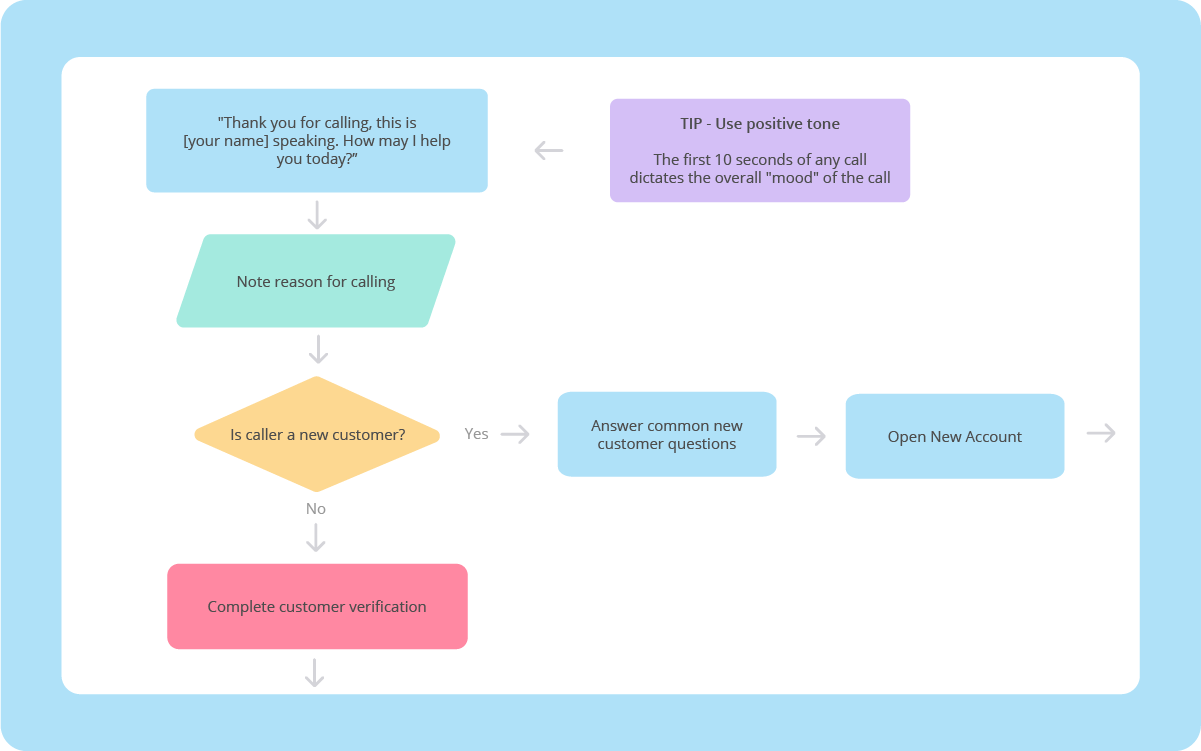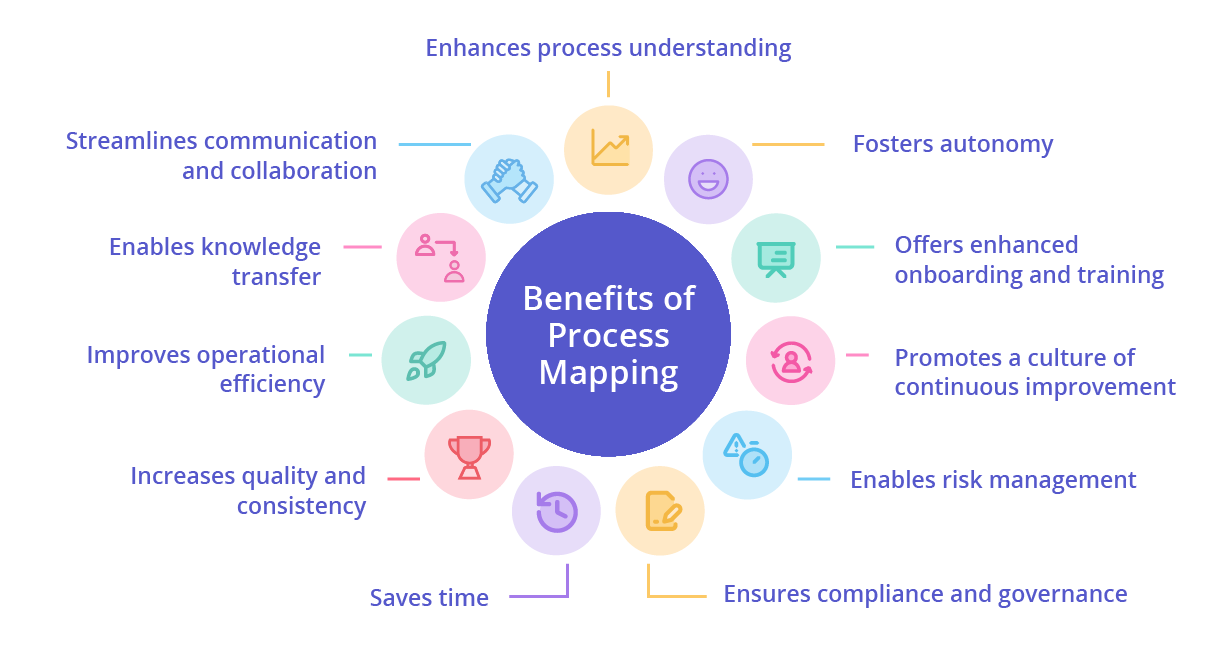Top 10 Benefits of Process Mapping

Key Takeaways
- Process mapping provides a clear, visual view of workflows, helping organizations identify bottlenecks, redundancies, and opportunities for improvement.
- Benefits include better communication, improved efficiency, faster onboarding, stronger compliance, and reduced risks.
- It supports knowledge transfer by capturing both explicit and tacit knowledge, preventing loss when employees leave.
- Process mapping fosters a culture of continuous improvement, enabling teams to adapt, innovate, and maintain high-quality, consistent results.
- Acting as a strategic tool, process mapping enhances transparency, boosts productivity, and makes organizations more competitive.
There are many benefits of process mapping in an organization, but its fundamental significance lies in its ability to make business operations more transparent and efficient.
This article takes a closer look at the captivating advantages that process mapping offers, including the top 10 benefits of process mapping and how it can improve productivity in the workplace.
What is process mapping?
Process mapping is a visual representation of an organization's processes used for documenting and improving existing processes, as well as training new employees. It guides users in analyzing, understanding, and managing business processes. It also allows for the unearthing of loops, inefficiencies, redundancies, or obsolete processes that impact the overall operation's performance.
As a fundamental part of improving business operations, process mapping is a strategic endeavor that enables businesses to have a bird’s eye view of their entire process workflow. By visually representing the steps involved in a process, it enables organizations to identify bottlenecks and points of inefficiency. It can offer businesses the necessary comprehension, insights, and perspectives about the various methods and workflows of their operations.
Through improved transparency, employees are equipped with a better understanding of processes and how their work impacts the whole organization.
Process mapping isn't just about identifying issues or challenges in operations management—it also uncovers opportunities for improvement. As an organization applies process mapping to its various operational activities, it becomes capable of marking the internal processes that are not adding value and hence, can be eliminated or simplified. This not only makes the business more efficient but also more competitive.
What are the benefits of process mapping?
Process mapping in business offers a multitude of benefits, particularly in fortifying efficiency, enhancing transparency, and identifying gaps and unnecessary complexities that can hinder productivity. It facilitates a thorough understanding of the entire process and fosters effective business decision-making.
Enhances process understanding
A visual view of a process promotes clarity as employees can grasp the entirety of the process, from its initiation to the endpoint. This simplifies complex processes and fosters a deeper comprehension of the interconnections between different stages. With clear visibility of end-to-end processes, employees can easily understand each step involved, bridging the gap between technical experts and non-specialists.
Streamlines communication and collaboration
Process mapping provides a standardized visual representation that simplifies collaboration among team members by making it easier for them to communicate complex processes. Everyone has a shared understanding of the workflow, eliminating ambiguity and reducing misunderstandings. By aligning individual perspectives and collectively working toward process improvement, it promotes holistic progress in the workplace.
Enables knowledge transfer
Process mapping encourages the documentation of both implicit and explicit knowledge and simplifies knowledge transfer to others. Additionally, as employees retire, change roles, or leave the organization, their tacit knowledge is often at risk of being lost. Process mapping helps capture and preserve this knowledge, allowing it to be transferred to new team members and preventing the loss of critical information.
Improves operational efficiency
Organizations can use process mapping to simplify complex processes and identify where a process starts, its path, where it ends, and evaluate if it is accomplishing the intended objective. They can uncover redundancies, bottlenecks, and underutilized resources within a workflow. By clearly illustrating the process, it draws attention to areas where optimization could streamline efforts, foster efficiency, and ultimately, save operational costs.
Increases quality and consistency
Process mapping guarantees consistency in the organization by establishing a standardized approach to operations and tasks, ensuring they are easier to manage, perform, and improve. It ensures quality control as there are no variations or deviations, in addition to decreasing the chance of errors as every employee adheres to the same agreed-upon process steps.
Saves time
By visually representing the steps of a process, organizations are provided with the clarity needed to streamline procedures, eliminate redundancies, and standardize workflows. Additionally, the utilization of a well-defined process map throughout training and onboarding allows new hires to quickly learn, understand, and retain the necessary processes required for the job. By continuously monitoring and improving processes, organizations stay agile, adapting to changing needs to establish maximum efficiency and pave the way for significant time savings in the long run.
Ensures compliance and governance
In sectors where regulatory compliance is mandatory, process mapping enables organizations to demonstrate their adherence to the required standards. It allows them to establish clear accountability structures, ensuring that every employee understands their role in compliance. By providing an easy-to-understand, condensed visual format that aligns with regulatory objectives, process mapping acts as a powerful solution for organizations seeking to uphold regulatory standards, adhere to governance frameworks, and promote a culture of accountability throughout their operations.
Enables risk management
By exposing potential problem areas within operations, process mapping assists in risk management. Through these insights, actions can be taken to proactively identify and evaluate risks associated with each process, ensuring smooth delivery of products or services even during peak demands, thereby solidifying a company's reputation for reliability and excellence.
Promotes a culture of continuous improvement
The transparency offered by process mapping encourages the sharing of ideas for process optimization among team members, thereby supporting a culture of continuous improvement where inefficiencies are consistently found and resolved. Additionally, the iterative nature of process mapping allows organizations to regularly review and refine their workflows based on performance data and feedback.
Offers enhanced onboarding and training
Process mapping acts as an effective training tool by offering a comprehensive overview of an organization’s processes, ensuring new hires have a clear and structured understanding of the steps involved. This visual aid simplifies the learning curve, accelerating the onboarding process and contributing to a more efficient and knowledgeable workforce. It offers a standardized reference point for training, ensuring that all team members receive consistent information.
By identifying opportunities for cross-training, process mapping enables employees to understand not only their roles but also the roles of their colleagues, fostering a more versatile and adaptable workforce.
Fosters autonomy
Acting as a visual guide, process mapping provides a structured framework that empowers employees to understand and navigate their roles independently. With minimal supervision required, team members can take ownership of their tasks and make informed decisions within the established guidelines. This encourages employees to make autonomous decisions as they are equipped with the knowledge they need to deliver their best work with confidence.

Getting started with process mapping
Process mapping proves to be instrumental in enhancing business operations and achieving organizational goals. Whether it's finding opportunities for strengthening communication, increasing quality control, or ensuring compliance, the benefits of process mapping offer a compelling way to view, understand, and improve the efficiencies of an organization.
To see how process mapping can help your organization drive better business outcomes, request a demo today.


